This isn’t the first time I’ve ranted about bad mulch choices and it certainly won’t be the last. But this pictorial cautionary tale is too important to pass up.
We already know that sheet mulches can be death to microbes, plant roots and animals living in the soil underneath. Our newly published research shows that landscape fabric reduces carbon dioxide movement between the soil and atmosphere about 1,000 times more than wood chip mulches do: plastic mulches are even worse. Oxygen movement will be likewise affected. And while gaps and holes in these barriers can lessen the impact, the question remains: why would you use ANY mulch that reduces gas movement? 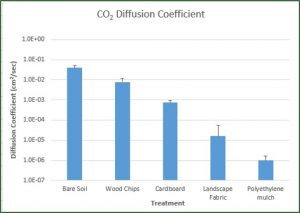 Yet people persist in using fabrics and plastics, usually to “smother” weeds (and that verb should set off alarm bells for anyone thinking about collateral damage to soil life). But weeds are weeds for a reason, and they will eventually colonize the surface of sheet mulches as soil, organic matter, and water collect over time.
Yet people persist in using fabrics and plastics, usually to “smother” weeds (and that verb should set off alarm bells for anyone thinking about collateral damage to soil life). But weeds are weeds for a reason, and they will eventually colonize the surface of sheet mulches as soil, organic matter, and water collect over time.
So without further ado, here is a case study of what happens when sheet mulch is used for landscape weed control.
These irrigated landscape beds are in Wenatchee, Washington, which has hot, dry summers. As you can see, bark mulch has been used to hide the shame of sheet mulching. And from a distance it looks…okay.
 Upon closer inspection, you can see the shroud of death emerging from the bark mulch (which has no means of staying in place, especially on a slope).
Upon closer inspection, you can see the shroud of death emerging from the bark mulch (which has no means of staying in place, especially on a slope).
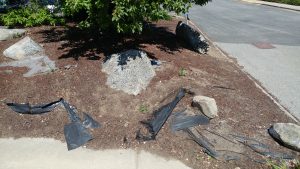 And even close you can see the soil that’s blown in, along with the bark and other organic matter. Just add water, and you get weeds!
And even close you can see the soil that’s blown in, along with the bark and other organic matter. Just add water, and you get weeds!
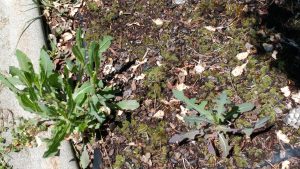 Weeds, weeds, weeds! Lots of weeds. Sunny weeds!
Weeds, weeds, weeds! Lots of weeds. Sunny weeds!
Rocky weeds!
 The weeds are thriving – but the trees are not. The crowns are dying…
The weeds are thriving – but the trees are not. The crowns are dying…
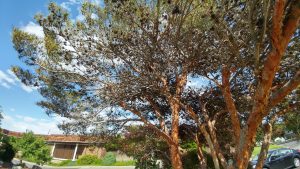 …and the trunks are suckering.
…and the trunks are suckering.
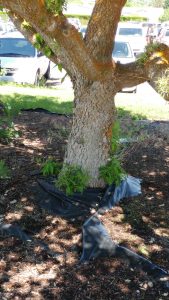 But you’ll note that the trees in the first photo outside of the beds are thriving.
But you’ll note that the trees in the first photo outside of the beds are thriving.
 And it’s all because of that “weed control fabric.” Which is working so well that this landscape had to be treated with herbicide the day I was there – to control the weeds.
And it’s all because of that “weed control fabric.” Which is working so well that this landscape had to be treated with herbicide the day I was there – to control the weeds.
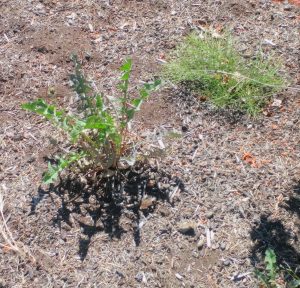
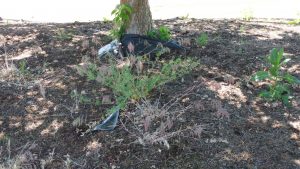
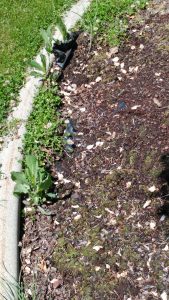

We use the fabric under rocks only areas. You are right that is doesn’t control weeds or grass in the flower beds.
Not to be pedantic, but “suckering” is a trigger for me. I agree these sprouts are indicators of tree stress, but they aren’t “sucking” anything more than other branches do.
Branches don’t sucker – they have watersprouts. Suckers arise from the roots. These are definitely from below ground.
I think this is more of a casual definition than a scientific one, but I’ll accept it. In that case, aren’t the roots suckering (not the trunk, as stated in the caption)?
To be honest I don’t know since I didn’t rip the whole thing apart as I was sorely tempted to do. In any case, it’s a water stress response.
whoa – it looks like they *wrapped* the tree flare with plastic! Landscape fabric comes up over and over when customers complain about tree/shrub decline. I’ve learned to ask “how did you prepare the bed,” and sometimes uncover this step. “How else am I going to keep down the weeds?” is how they respond. Nobody wants to *tend* their gardens, they just want to have them done – I show them around the nursery – we weed ALL the time by hand and hula-hoe! Otherwise “pave paradise and put up a parking lot!”
As I recall, the practice of ‘mulching’ with plastic began in the 1970s. When we moved into our current garden 14 years ago, I discovered that an enormous area had been landscaped in the mid-1970s with heavy black plastic topped with about 12 inches of soil, then another layer of black plastic (into which shrubs were planted) and then topped with 4 inches of river rock. It probably looked good at first but the plants obviously suffered over the years.
Leaves and other debris filled in spaces between the rocks and eventually the shrubs’ roots began to grow into the rocks. What a mess! It took me 3 years to remove most of it but I couldn’t get it all. Several of the sickly rhodos died in the process.
That landscaping philosophy is still alive and thriving today. Too often I hear friends and relatives talk about their landscaping plans which they assume includes the need to put down landscape fabric.
How did you remove the fabric which is covered by layers of soil and “stuff”? We just moved last year and all the foundation plants around the house are planted in landscape fabric. I would like to remove it so I can plant new plants. I can’t even get a pointed shovel or knife through it! Been there for years. Thank you for your help.
You will have to dig everything out. Use scissors to cut the fabric away from the plants and remove it piece by piece. When you’ve removed a section, cover the area with a wood chip mulch and water well to protect the soil and roots. It’s a slog but if you are careful you can do this.
Because I have artillery fungus, I use flexible screening under pebble mulch at the house perimeter to prevent the stones from sinking into the soil and, of course, pull the weeds as they pop up; otherwise it’s wood chips throughout the landscape.
A reputable landscape architect and instructor told me “Nothing is wrong with landscape fabric as long as it is made of coir (coconut fiber) [because it] is biodegradable.” Do you agree?
Landscape fabric, as understood by most people, is densely woven fabric. That’s what you see in stores. Coir cloth is sold as such. It does not keep out weeds but serves to keep mulch in place. It is loosely woven so it does not block water, air or light for that matter. Its function is entirely different from landscape fabric and the names need to be kept distinct to reflect that.
Moved into a new (old) house last August. Landscape fabric everywhere! Doing nothing to stop weeds, of course. To my horror, when I started digging and pulling it out, there was not a single worm under the fabric. I used landscape fabric at my old house under stone dust for a patio. Seeds land on the surface of the stone dust and sprout. It’s the only appropriate use of landscape fabric that I can think of and it certainly wasn’t perfect for the job.
And then there are people online promoting both landscape fabric and plastic (!) as great alternatives to wood chip mulch. So much incorrect information on that site and no comments area to refute it (of course). Post that link to social media and thousands of people will think the information is gospel.
I often think that scientifically based horticulture is a lost cause.
Hi John –
I had to edit your comment to delete the link to the offending website (we don’t give commercial websites free advertising here. I feel your pain! But I also see more and more houses with giant woodchip piles in front of them, and know from personal experience it’s getting harder to get chips quickly. So science is making its way slowly through the gardening community. The best selling point is visual evidence over the years: no weeds (wood chips) vs. weed disaster (fabric and plastic).
I certainly agree with your recommendations to not use landscape fabrics in any location where one is gardening, growing, or landscaping due to the soil health issues it causes. One area where high-quality engineered fabrics have a lot of usefulness and utility in my experience, however, is with hardscape installation.
I am building terraces on a strongly sloped backyard in heavy Maryland clay, and the SRW Products’ NW4 filtration and drainage fabric does a great job of providing a barrier between fine clay silt and base rock for drainage under and behind the terrace walls.
The fabric seems to allow water to filter through without becoming too clogged with silt and enter the drainage column behind each wall. This reduces the freeze and thaw heaving in the soil behind each wall enough that it increases the stabilization and resilience of the wall, giving it a longer life and better function in creating level terraces on a significantly sloped yard, increasing the usability of the land for gardening.
Hopefully you would agree that these applications of high-quality landscape fabric make sense. So far, they’ve worked great for me. Do you have any concerns for this kind of use?
Since I don’t have any qualifications as an engineer I can’t say whether this is a recommended use. The application doesn’t involve plants or soil life, so it doesn’t really matter if oxygen can permeate. I can tell you that (1) fabric will break down if only by shearing force and (2) the holes will fill with soil particles and reduce water movement. I would think hardware cloth might be a better choice?
I had a gorgeous peach tree growing on the edge of my lake and grandpa thought he’d cage it in to protect it from deer. Great intention but the finishing touches of putting down the lawn fabric was the trees undoing. It started getting leaf spot and usually defoliate completely by august (east coast). It took me 3 years to figure out why every subsequent tree experienced the same issue. Well, the lawn fabric was doubled up and prevented the soil from breathing. It retained lots of water to the point of ammonia odors. I had to remove all the mulch to discover the lawn fabric. I then amended the ammonia soil with ashes, citrus peels, corn meal, etc. Then added some shrubs to soak up residual water.
This was a tough lesson to learn….through trial and error. The new cherry tree is doing well.
Hi Roger –
Congratulations on getting that fabric out of there! But I do want to caution you about adding all those amendments without having a soil test first to determine your nutrient levels. It is very easy to overfertilize and nutrient toxicities are difficult to eradicate.
Hi,
I presume when you refer to landscape fabric you are talking about woven fabric?,
What are your thoughts on Non woven fabrics, I have been using non woven/ spun bonded and have found them successful it is very light and has holes impregnated through that allow water and air to flow through,
When i have removed from gardens when doing alterations the soil and gardens still have life instead of being dead as i have experienced removing woven fabric.
Im interested in your thoughts?
Kind regards
Sean
Any sheet mulch will create a barrier to water and air movement – this has been firm established with published research (https://pubag.nal.usda.gov/catalog/6552945). Those holes are quickly filled with soil which makes it even more impermeable. You can see this yourself if you take a piece of the fabric and rubber band it over a container, make a shallow indentation, place a bit of soil inside, then fill with water. There’s very little water movement, especially compared to soils covered with chunky mulches.
Appreciate the factual information on weed fabric to share, as I see online comments all the time about using fabric. In the beginning of your “Cautionary Tale,” you mention the fabric prevents oxygen from reaching the soil life beneath it. While you address primarily the ultimate lack of weed supression, it would be interesting, too, to understand the impact on the microbial life beneath the fabric vs chips vs native vegetation.
If you look at the figure at the very top of the post you will see exactly the different on microbial life that chips vs. fabric (and other sheet mulches) have. The interference with gas transfer means microbial life (and anything else living in the soil) can’t respire effectively.
Native vs. nonnative vegetation will not show significant differences on microbial life. What’s important for microbial diversity (and all biodiversity) is a diversity in plant life. Monoculture plantings will support the least biodiversity; the provenance of the mononculture makes no difference.
Thank you for sharing your information! I moved into a house about 3 years ago with a beautiful mature orange tree, but all the garden bed areas have weed barrier fabric and large rocks over them. The orange tree has been struggling for the past two years, and I have long been wondering if the weed barrier fabric has been part of the problem. A lot of the outer canopy leaves have been falling off, but the inner branches seem to be doing ok. I’ve been feeding the tree with water soluble fertilizer a few times a year, but have been worried about what else I should be doing for the health of the tree.
I will try carefully removing the weed barrier and mulching with organic mulch and see if that helps. I live in a hot dry zone 9b climate in northern California, should I be careful about what time of year I remove the weed barrier cloth?
Thank you!
The best time is in the fall, when temperatures are cooler, the soil moisture is higher, and plants are dormant. Otherwise you risk injury to roots and stress to the aboveground portions of the plants.
Hi-We have a row of pine trees (mainly blue spruce) which have been diagnosed with needlecast disease. The company has been applying fungacide and deep root fertilizer to help fight needlecast. They recommended mulching under trees for better weed control. Rationale is that since needlecast get worse with wet conditions avoiding thick weed/grass growth under trees will help drainage. Any recommendations about how to mulch for best results? We live in Ohio.
Arborist wood chips are, by far, the best mulch you can use for trees.
Just so you know, deep root fertilization is a waste of money and resources. Fine roots are near the surface of the soil. There’s not enough oxygen deeper in the soil, particularly since you apparently have drainage issues.
Hi Linda, Thank you so much for this post!! I have a question if you are not too busy. I lost four 25 foot pines over the winter here in Toronto Canada. One big wet snow storm and they all came down. The root balls came right up. There weren’t any deep or wide roots at all. I found that the previous owner had black landscape fabric right up to the trees. The soil under was like wet clay. Although they were planted approx 15 years ago, could this instability and shallow root system be due to the landscape fabric?
If so, I have other tall pines with the fabric as well. Can I remove it all now in the spring or should I wait till late fall? Thanks so much!!
Hi Joel –
Yes, you will want to remove all that fabric as much as you can. Wait until fall when temperatures are cooler and soil is moister. Replace that fabric with arborist chips. This won’t solve the potential problem of improper planting (i.e., not removing the burlap or clay around the roots) but it will make the environment more hospitable for root growth.
enjoyed reading your site. Thank you.